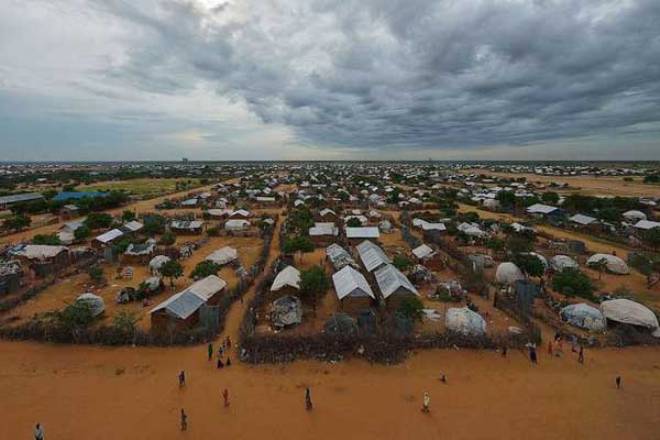
Saturday October 3, 2015

An aerial view of part of the eastern sector of the Ifo II camp in the sprawling Dadaab refugee camp on April 28, 2015. AFP PHOTO | TONY KARUMBA
advertisements
The United States government quietly pressured Kenyan authorities to expand the Dadaab camp, as more Somali refugees poured into Kenya to flee famine and terrorists.A new trove of emails published by the State Department on Wednesday show that officials from the American government prevailed upon the then Grand Coalition government to open the Ifo II sub-camp in 2011.
In 2011, Kenya was facing an influx of refugees coming to the Dadaab camp in Garissa County.
The camp had by that time been stretched five times, hosting 420,000 refugees from the intended 90,000.
At the height of the refugee crisis, Mr Raila Odinga travelled to Dadaab alongside other government officials, including then Internal Security Minister George Saitoti. The trip also included US government officials and it followed Kenya’s announcement that it would no longer allow any more refugees.
But during this trip, Mr Reuben Brigety, then assistant secretary of state, discussed the plight of refugees with Mr Odinga and Prof Saitoti.
“I spent eight hours yesterday directly PM Odinga, traveling in his vehicle as we toured the refugee camps at Dadaab, walking next to him as we talked with refugees in the hospital and reception center, sitting with him and FM (sic) Saitoti during meals, and sitting next to him on his private plane en route back to Nairobi (during which we talked one on one for an hour),” Mr Brigety wrote to Washington on July 15, 2011.
ODINGA WEPT
Mr Brigety has since been appointed the US envoy to the African Union in Addis Ababa.
“You will get detailed readouts through channels, but in summary he is deeply seized with this crisis in Somalia and decided on the spot to open the long-promised Ifo ll camp, something the international community has been asked for at least two years now,” he stated in the letter.
During his tour of the camp that Thursday, Mr Odinga ‘wept’ after seeing emaciated children and women who had trekked long distances and were now in the long queues to be registered.
The Grand Coalition government had initially closed the border with Somalia and later said there would be no further admissions to Dadaab because it was full.
But as the crisis thickened, at one time, the Immigration ministry, then under Otieno Kajwang’, contradicted Prof Saitoti’s office on the closure of the camp.
Prof Saitoti argued the influx was a security hazard. “We have security concerns that Al-Shabaab could be coming into our country under the guise of refugees,” he told reporters in July 2011.
But Mr Kajwang countered by saying it was Kenya’s duty to protect refugees.
“The problem is that our provincial administration (officials based in Mr Kibaki’s office) and our security officers look at the huge influx as a threat to national security,” he told the BBC.
“On the other hand, we see it as a crisis that must be managed. It is our responsibility under international law and our own law,” he added.
The lobbying by the US and NGOs had followed the rising numbers of Somalis fleeing famine and terrorists in Somalia. The UN Office for the Coordination of Humanitarian Affairs (UNOCHA) had warned that the numbers could keep rising.
CRISIS
Despite the crowding at Dadaab, UNOCHA reported a daily arrival of 3,000 people, exceeding the usual three per cent that is usually the basis for declaring it a refugee crisis.
Kenya had initially set up a new extension called Ifo II to house more refugees. But that plan was shelved after officials argued it would breed insecurity. During the crisis, Ifo II stood empty, leading to a series of lobbying.
Oxfam appointed "Sex in the City" actress Kristin Davis as a humanitarian ambassador and several other NGOs, including MSF (Doctors Without Borders) and the World Food Programme invited global media organisations to cover the crisis.
The day Mr Odinga travelled to Dadaab, he announced that the Kenya-Somali border would immediately be reopened and refugees would be allowed into the Ifo II camp.
The Somali famine was part of the entire crisis in the Horn of Africa. The UN estimated that about 12 million people faced starvation and most were from Somalia.
Though the camp was expanded, Somalia alone lost 100,000 people to starvation while about 260,000 people died in the whole region.